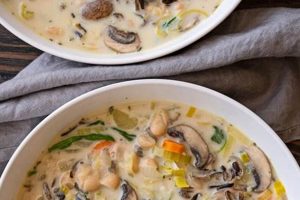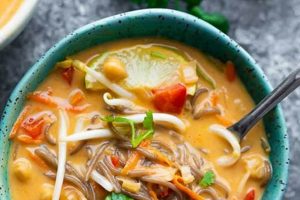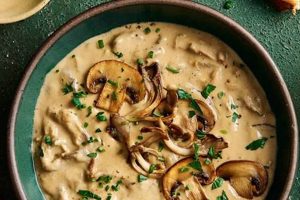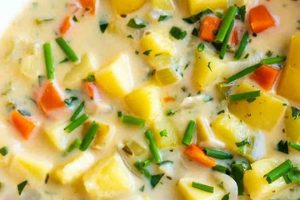The combination of pressure cooking and plant-based ingredients allows for the rapid creation of flavorful and nutritious meals. These dishes leverage the speed and efficiency of electric pressure cookers to transform vegetables, legumes, and grains into comforting and healthy food options suitable for a variety of dietary needs. For example, a creamy tomato and basil creation, traditionally requiring hours of simmering, can be achieved in a fraction of the time.
Employing an electric pressure cooker to prepare plant-based liquid meals offers numerous advantages. The accelerated cooking process preserves more nutrients compared to conventional stovetop methods. It also allows for the development of deeper, more complex flavors as ingredients meld together under pressure. Historically, slow-cooked stews were the primary method; however, modern technology now provides a convenient and faster alternative, fitting seamlessly into contemporary lifestyles and promoting easier access to wholesome food.
The following sections will detail specific recipes and techniques for crafting a diverse range of satisfying and healthful dishes using these methods. These recipes will encompass a variety of global cuisines and dietary preferences, showcasing the versatility and adaptability of this approach to plant-based cooking.
Tips for Electric Pressure Cooker Preparation of Plant-Based Liquid Meals
This section provides essential guidance for successfully preparing plant-based liquid meals using an electric pressure cooker, ensuring optimal flavor, texture, and safety.
Tip 1: Utilize Sufficient Liquid. Adequate liquid is crucial for pressure cooking. Ensure the recipe includes enough broth, water, or plant-based milk to facilitate proper pressure build-up and prevent burning. A general guideline is to have at least one cup of liquid.
Tip 2: Layer Ingredients Strategically. Place denser ingredients like potatoes or carrots at the bottom of the pot, closer to the heat source. More delicate ingredients, such as leafy greens or herbs, should be added later, either after pressure cooking or during a quick saut, to maintain their integrity.
Tip 3: Employ the Saut Function. Before pressure cooking, use the saut function to bloom spices and caramelize vegetables like onions and garlic. This enhances the overall flavor profile of the final dish, creating depth and complexity.
Tip 4: Adjust Cooking Time Based on Ingredient Density. Different ingredients require varying cooking times under pressure. Legumes generally need a longer cooking time than softer vegetables. Refer to reputable recipe sources for accurate cooking times to prevent undercooking or overcooking.
Tip 5: Monitor the Natural Pressure Release. Allowing the pressure to release naturally (NPR) after cooking often results in better flavor development and prevents ingredients from becoming mushy. However, for quicker results, a quick pressure release (QPR) can be used, but exercise caution.
Tip 6: Season After Cooking. Pressure cooking can sometimes mute flavors. Taste and adjust seasonings, such as salt, pepper, and herbs, after the cooking cycle is complete to achieve the desired taste.
Tip 7: Thicken as Needed. If the finished dish is too thin, use the saut function to simmer and reduce the liquid to the desired consistency. Alternatively, create a slurry of cornstarch or arrowroot powder with cold water and stir it into the dish during the last few minutes of cooking.
By adhering to these guidelines, one can consistently produce exceptional results, maximizing both flavor and efficiency when crafting plant-based liquid meals in an electric pressure cooker. These techniques allow for the quick and easy creation of nutritious meals.
The subsequent discussion will explore the nutritional aspects and health benefits associated with these types of meals.
1. Efficiency
The relationship between electric pressure cookers and plant-based liquid meals is fundamentally intertwined with the concept of efficiency. The accelerated cooking times offered by electric pressure cookers directly address the common time constraints associated with meal preparation. This efficiency enables the more frequent incorporation of plant-based meals into daily diets, fostering consistent adherence to dietary guidelines. This is because the prolonged simmering times often required for traditional plant-based preparations, such as softening root vegetables or cooking dried legumes, are significantly reduced.
The increased efficiency extends beyond mere time savings. It also minimizes energy consumption compared to stovetop cooking, contributing to reduced utility costs and a smaller environmental footprint. A specific example is the preparation of a hearty bean-based dish, which could require several hours of stovetop simmering to achieve the desired texture. An electric pressure cooker can accomplish the same result in a fraction of the time, using less energy and requiring minimal monitoring. The efficiency also allows for batch cooking and meal prepping, optimizing time management throughout the week.
The ability to quickly and easily prepare nutritious plant-based meals directly addresses a significant barrier to adopting a vegan diet. Individuals with limited time resources can readily integrate these meals into their routines, making plant-based eating more accessible and sustainable. The benefits of this efficiency include improved dietary adherence, reduced energy consumption, and greater ease in meal planning, all contributing to a more healthful and environmentally conscious lifestyle.
2. Flavor Depth
The preparation of plant-based liquid meals within an electric pressure cooker environment significantly influences the development of flavor depth. The sealed cooking chamber and elevated pressure levels facilitate unique chemical reactions and ingredient interactions, leading to enhanced taste profiles that differ considerably from those achieved through conventional cooking methods.
- Maillard Reaction Acceleration
The Maillard reaction, a chemical process responsible for browning and the development of complex flavors, occurs more rapidly under the high-temperature conditions within an electric pressure cooker. This acceleration is particularly noticeable when sauting aromatic vegetables such as onions, garlic, and shallots before pressure cooking. The resulting caramelized notes contribute a foundational layer of richness and savory depth to the finished dish.
- Infusion and Ingredient Integration
The sealed environment promotes a more efficient infusion of flavors between ingredients. As ingredients cook under pressure, their volatile compounds are trapped within the pot, leading to a more concentrated and harmonious blend of tastes. Herbs, spices, and other flavorings penetrate deeper into the core of the dish, creating a more cohesive and impactful flavor experience.
- Cell Wall Breakdown and Texture
The pressure cooking process aids in breaking down the cell walls of plant-based ingredients, releasing natural sugars and starches. This contributes to a smoother, creamier texture in the finished soup while simultaneously enhancing the sweetness and umami notes. The breakdown also allows for easier absorption of flavors by the palate, further enriching the overall taste experience.
- Reduction and Concentration of Liquids
While pressure cooking does not inherently reduce liquids, the subsequent simmering phase, often employed to thicken the liquid to the desired consistency, results in flavor concentration. As excess water evaporates, the remaining flavors become more intense and pronounced, creating a more robust and satisfying flavor profile.
These facets collectively contribute to the profound flavor depth achievable in plant-based liquid meals prepared within an electric pressure cooker. The accelerated Maillard reaction, efficient ingredient integration, cell wall breakdown, and flavor concentration contribute to an enhanced culinary outcome. These processes yield a more complex and rewarding taste experience, highlighting the unique advantages of this cooking method.
3. Nutrient Retention
The use of electric pressure cookers in preparing plant-based liquid meals directly impacts nutrient retention within the ingredients. Conventional cooking methods, particularly boiling, can lead to significant nutrient loss due to leaching into the cooking water and degradation from prolonged exposure to heat and oxygen. Pressure cooking, however, minimizes these losses through reduced cooking times and a sealed cooking environment. This is especially vital for water-soluble vitamins, such as Vitamin C and B vitamins, which are particularly susceptible to degradation during prolonged heating. An example is the cooking of broccoli: pressure cooking retains a significantly higher percentage of its Vitamin C content compared to boiling. Therefore, this method helps to create a more nutrient-dense meal.
The reduced cooking times are crucial in preserving heat-sensitive nutrients. The faster the food cooks, the less time these nutrients have to break down. Additionally, the sealed environment minimizes oxidation, which can also degrade vitamins and antioxidants. The shorter cooking period also positively impacts the texture of vegetables, preventing them from becoming overly soft and mushy, which is a sign of nutrient loss. For instance, when preparing a lentil-vegetable dish, the lentils cook quickly without prolonged simmering, allowing the vegetables to retain their color, texture, and nutritional value. This preservation contributes to the overall health benefits of the dish.
In summary, the employment of electric pressure cookers for plant-based liquid meal preparation is a strategy for maximizing nutrient retention. The shortened cooking times, minimal water usage, and sealed environment collectively reduce nutrient loss compared to traditional methods. This advantage directly supports the consumption of more nutritious meals, aligning with dietary guidelines that prioritize nutrient-rich foods. Understanding this connection encourages the efficient and healthy preparation of plant-based meals, but it also necessitates careful selection of quality ingredients to optimize the outcome.
4. Ingredient Versatility
The utility of plant-based liquid meals prepared via electric pressure cookers is significantly enhanced by the inherent flexibility regarding ingredient selection. This allows for adaptation to dietary restrictions, seasonal availability, and personal preference, making it easier to meet nutritional requirements while minimizing food waste.
- Legume Integration
Dried legumes, such as lentils, beans, and peas, can be incorporated directly into the pressure cooking process without pre-soaking, streamlining meal preparation. These ingredients contribute substantial protein and fiber to the dish. Chickpeas, for instance, can be combined with spices and vegetables to create a quick and hearty meal, exemplifying the convenience and versatility of legume integration.
- Seasonal Vegetable Adaptation
The adaptability to seasonal produce expands the culinary possibilities of plant-based dishes. Root vegetables like carrots and parsnips in winter can be combined with leafy greens in spring or summer, allowing for nutrient intake optimization based on seasonal availability. A harvest vegetable mix can make a rich and nutritious autumn plant based meal.
- Grain Inclusions
Grains, such as quinoa, barley, and rice, can be combined with vegetables and broths to enhance the texture and nutritional profile. Adding quinoa to a vegetable broth increases the protein and fiber content, transforming a simple dish into a complete meal. The pressure cooker efficiently cooks these grains in tandem with other ingredients.
- Global Cuisine Adaptation
The inherent adaptability of these cooking methods lends itself to the replication of a diverse range of global cuisines. Ingredients and spice profiles can be adjusted to create dishes inspired by various culinary traditions. By using different spices and vegetables, a dish could be inspired by Thai curry or even Italian minestrone, all while maintaining a plant based and healthy meal.
The facets described above collectively highlight the expansive culinary opportunities presented by this preparation method. By embracing the flexibility of ingredient selection, cooks can create diverse, nutritious, and satisfying dishes tailored to their specific needs and tastes, leveraging the inherent efficiency of the electric pressure cooker.
5. Time Savings
The accelerated preparation of plant-based liquid meals using electric pressure cookers offers significant time savings compared to traditional methods. This temporal advantage is a crucial factor in the adoption and maintenance of plant-based diets, particularly for individuals with demanding schedules.
- Reduced Cooking Time for Legumes
Dried legumes, such as lentils and beans, typically require extensive soaking and simmering before they are palatable. Electric pressure cookers drastically reduce this time, often eliminating the need for pre-soaking and decreasing the cooking time to a fraction of what conventional methods require. A bean that might necessitate hours of stovetop cooking can be ready in approximately one hour in an electric pressure cooker, saving substantial preparation time.
- Simultaneous Cooking of Multiple Ingredients
Electric pressure cookers allow for the simultaneous cooking of various ingredients, such as grains, vegetables, and spices, in a single pot. This eliminates the need for separate cooking steps and reduces overall preparation time. An all-in-one process streamlines meal creation, consolidating efforts and minimizing the active involvement of the cook.
- Automated Cooking Process
The automated nature of electric pressure cookers further contributes to time savings. Once the ingredients are added and the cooking settings are selected, the device handles the cooking process autonomously. This frees up the individual to attend to other tasks while the meal is being prepared, optimizing time management. The user can set the device and return later to a finished dish.
- Simplified Cleanup
The use of a single pot for cooking minimizes cleanup efforts. Electric pressure cookers typically feature non-stick interiors, which further simplifies the cleaning process. This streamlined approach reduces the time spent on post-meal cleanup, contributing to overall time savings associated with meal preparation.
These aspects collectively illustrate the substantial time savings achieved through the use of electric pressure cookers in the preparation of plant-based liquid meals. The reduced cooking times for legumes, simultaneous cooking of ingredients, automated cooking process, and simplified cleanup efforts all contribute to a more efficient and convenient meal preparation experience, making plant-based eating more accessible and sustainable.
6. Dietary Adaptability
The intrinsic nature of plant-based liquid meals prepared in electric pressure cookers promotes dietary adaptability, serving as a crucial element in catering to diverse nutritional requirements and preferences. The fundamental flexibility in ingredient selection allows for straightforward adjustments to accommodate specific dietary restrictions, allergies, or individual health goals. This adaptability transforms plant-based pressure-cooked liquid meals from a generalized food option into a personalized dietary solution.
Consider, for example, individuals with gluten intolerance. Recipes can easily be modified to exclude gluten-containing grains and thickeners, relying instead on naturally gluten-free ingredients like quinoa, rice, or tapioca starch. Similarly, those with nut allergies can avoid nut-based creams or butters, opting for alternatives such as sunflower seed butter or blended silken tofu to achieve a creamy texture. The absence of animal products inherently makes these recipes suitable for individuals following vegan or vegetarian diets, and further modifications can address specific needs, such as low-sodium diets or restrictions on specific vegetables due to medical conditions. The ease with which recipes can be adapted directly addresses the challenges often associated with adhering to specialized diets.
In conclusion, the capacity for dietary adaptation is a central advantage of preparing plant-based liquid meals in electric pressure cookers. The ability to customize recipes based on individual needs ensures greater adherence to dietary guidelines and promotes healthier eating habits. This flexibility also diminishes the barriers often encountered when navigating dietary restrictions, making nutritious and palatable plant-based meals accessible to a wider range of individuals. A thorough awareness of this adaptability supports informed choices when developing plant-based dishes.
Frequently Asked Questions
The subsequent section addresses common inquiries and misconceptions surrounding the preparation of plant-based liquid meals utilizing electric pressure cookers. These responses aim to provide clarity and promote informed decision-making.
Question 1: Is it necessary to soak beans before cooking them in an electric pressure cooker for soup?
While pre-soaking dried beans can reduce cooking time and potentially improve digestibility, it is not strictly necessary when using an electric pressure cooker. The high pressure and temperature inside the cooker soften the beans effectively, often eliminating the need for pre-soaking. However, cooking times may need to be adjusted accordingly.
Question 2: Can frozen vegetables be used in instant pot vegan soups?
Frozen vegetables can be readily incorporated into preparations. Frozen vegetables often retain their nutritional value due to flash-freezing processes. Adding frozen vegetables may slightly increase cooking time, but the overall impact is typically minimal.
Question 3: How can burning be prevented when cooking thick vegan soups in an instant pot?
Burning can occur if there is insufficient liquid or if starches settle at the bottom of the pot. To prevent this, ensure an adequate amount of liquid is used. Layer dense ingredients at the bottom, stir frequently before sealing the pot, and use the “saut” function judiciously to avoid scorching. A trivet can also be utilized to elevate ingredients above the heat source.
Question 4: Will pressure cooking vegetables diminish their nutritional content?
Pressure cooking, in general, tends to retain more nutrients than boiling due to shorter cooking times and reduced water usage. However, some water-soluble vitamins may still leach into the cooking liquid. Consuming the liquid, as in a soup, helps retain these nutrients. The impact on heat-sensitive vitamins should also be considered; shorter cooking times mitigate losses.
Question 5: What is the best way to thicken a vegan soup made in an instant pot?
Several options exist for thickening plant-based liquid meals. A slurry of cornstarch or arrowroot powder mixed with cold water can be added towards the end of the cooking cycle. Pureed cooked vegetables, such as potatoes or squash, can also add thickness and creaminess. Allowing the soup to simmer uncovered after pressure cooking will reduce the liquid volume, further thickening the consistency.
Question 6: Is it safe to leave an instant pot unattended while it is pressure cooking vegan soup?
Electric pressure cookers are designed with multiple safety mechanisms. Once properly sealed and set, it is generally safe to leave the appliance unattended. However, it is essential to ensure the pressure release valve is unobstructed and to follow the manufacturers instructions. Regularly inspect the appliance for any signs of damage or malfunction.
Key takeaways include understanding the suitability of dried beans and frozen vegetables, techniques for preventing burning, and methods for thickening recipes. The importance of adhering to safety guidelines remains paramount.
The following section will address specific recipes and flavor combinations.
Conclusion
This exploration has elucidated the multifaceted advantages of crafting plant-based liquid meals using electric pressure cookers. The combination of efficiency, enhanced flavor development, nutrient retention, ingredient versatility, time savings, and dietary adaptability underscores the value of this methodology. The presented information has addressed common concerns and offered practical solutions, emphasizing both safety and optimal culinary outcomes.
The capacity to quickly produce nutritious and palatable plant-based meals represents a significant contribution to promoting dietary health and sustainability. Continued adoption of these techniques offers the potential to broaden access to healthful food options, reducing reliance on resource-intensive food production systems and facilitating more conscientious consumption patterns. The future promises further innovation and refinement of these methods, increasing their accessibility and impact on global dietary practices.







